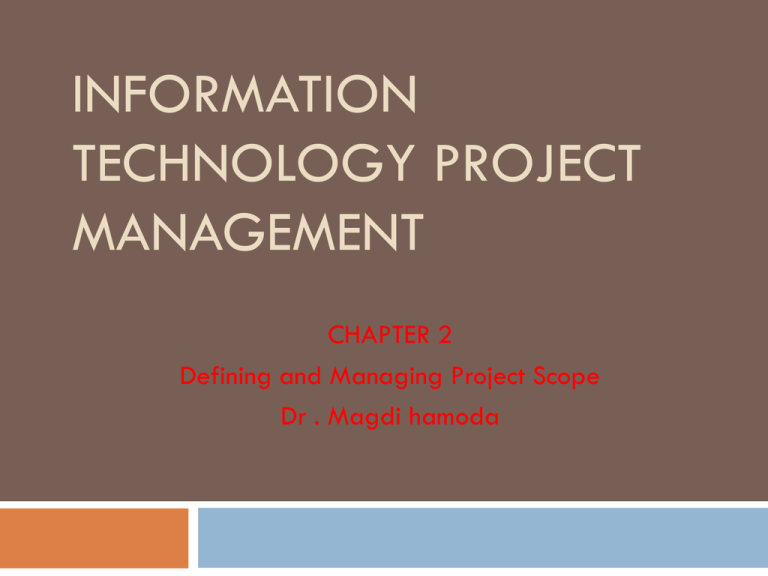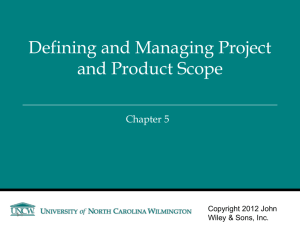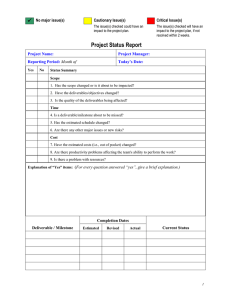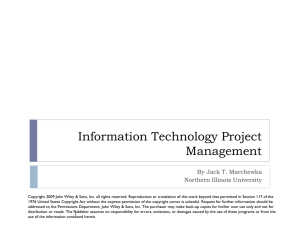موضوعات مختارة
advertisement

INFORMATION TECHNOLOGY PROJECT MANAGEMENT CHAPTER 2 Defining and Managing Project Scope Dr . Magdi hamoda Learning Objectives Identify the five processes that support project scope management. These processes, defined by PMBOK®, include initiation, planning, scope definition, scope verification and scope change control. Describe the difference between product scope and project scope. Apply several tools and techniques for defining and managing the project’s scope. Scope The deliverables or work products that must be completed in order to achieve the project’s MOV. Provides a boundary so that what needs to get done – gets done. Otherwise, schedule and budget are increased Defines what is part of the project team’s work and what is not. Provides a link between the project’s MOV and the project plan. Project Planning Framework MOV Scope Sequence Phases Schedule Tasks Resources Time Estimates Budget PMBOK Scope Management Processes Scope Management Process Description Scope Planning The development of a scope management plan that defines the project’s scope and how it will be verified and controlled throughout the project. Scope Definition A detailed scope statement that defines what work will and will not be part of the project and will serve as a basis for all future project decisions Create Work Breakdown Structure (WBS) The decomposition or dividing of the major project deliverables into smaller and more manageable components. Scope Verification Confirmation and formal acceptance that the project’s scope is accurate, complete, and supports the project’s MOV. Scope Change Control Ensuring that controls are in place to manage proposed scope changes once the project’s scope is set. These procedures must be communicated to all project stakeholders. Scope Management Plan Scope Planning Documents how team will define & develop project scope. Scope management plan Scope Definition Builds upon preliminary scope stmt to define all project and product deliverables Detailed scope Scope Verification Scope Control Project planning tool subdivides the scope into deliverable hierarchy Formalized acceptance from appropriate stakeholders tat defined scope complete Defined process for managing changes & impact to budget & schedule WBS Verification checklist Change control process Create WBS Problems with Scope Ambiguous Ambiguity in scope leads to confusion and unnecessary work. Incomplete Incomplete scope leads to schedule slips and hence finally cost overrun. Transient Transient scope leads to what is known as scope creep which is the primary cause of late deliveries and potentially "never ending" projects. Uncollaborative A scope that is not collaborated leads to misinterpretations in requirements and design. Capture Project Scope Success Define the project need Identify key stakeholders Identify project drivers Develop operational concepts Identify external interfaces Project Scope Initiation & Planning A beginning process that formally authorizes the project manager and team to develop the scope management plan This entails Conceptualizing the Scope Boundary Developing the Scope Statement The Scope Boundary “Failure to define what is part of the project, as well as what is not, may result in work being performed that was unnecessary to create the product of the project and thus lead to both schedule and budget overruns.” - Olde Curmudgeon, 1994 The Scope Statement Provides a way to define the scope boundary. A narrative of what deliverables or work-products the project team will and will not provide throughout the project. A first step that provides a high-level abstraction of the project’s scope that will be defined in greater detail as the project progresses. Scope Statement Example – Work within the scope boundary 1. Develop a proactive electronic commerce strategy that identifies the processes, products and services to be delivered through the World Wide Web. 2. Develop an application system that supports all of the processes, products and services identified in the electronic commerce strategy. 3. The application system must integrate with the bank’s existing enterprise resource planning system. Scope Statement Example – Work outside the scope boundary 1. Technology and organizational assessment of the current environment 2. Customer resource management and data mining components Project Scope Definition Project-Oriented Scope Deliverables that support the project management and IT development processes defined in the Information Technology Project Methodology (ITPM). Examples : Business case, project charter and project plan, etc. Product-Oriented Scope High-level features and functionality of the application system First cut for requirements definition that will be defined in greater detail during the systems development life cycle (SDLC) Examples : Add new customer, look up customer balance, print daily sales report by region, etc. Project-Oriented Scope Definition Tools Deliverable Definition Table (DDT) Deliverable Structure Chart (DSC) Deliverable Definition Table Deliverable Structure Standards Approval Needed By Resources Required Business Case Document As defined in project methodology Project Sponsor Business Case team & OA tools Project Document charter & project plan As defined in project methodology Project Sponsor Project manager, sponsor, & OA tools Technology Document & Org. assessment As defined in project methodology Project manager & Sponsor Bank’s syst. analyst, OA & case tools Requirements definition As defined in project methodology Project manager Syst. analyst programmer Case & OA Document Deliverable Structure Chart Product-Oriented Scope Definition Tools Context Dataflow Diagram (DFD) Use Case Diagram (USD) Context Level Data Flow Diagram Use Case Diagram Scope Verification Ensures: That the project’s scope is well-defined, accurate and complete The project’s scope is acceptable to the project stakeholders That standards exist so that the project’s scope will be completed correctly That the project’s MOV will be achieved if the project scope is completed Tools Scope Verification Checklist Scope Verification Check List MOV – Has the project’s MOV been clearly defined and agreed upon? Deliverables – Are the deliverables tangible and verifiable? Do they support the project’s MOV? Quality Standards - Are controls in place to ensure that the work was not only completed but also completed to meet specific standards? Milestones – Are significant events that mark the acceptance of a deliverable and give the project manager and team the approval to begin working on the next deliverable Review and Acceptance Scope Change Control Ensures that any changes to the project’s scope will help the project achieve its MOV. Keeps the “triple constraint” in balance. Scope Change Control Mitigates: Scope Grope – i.e., scope poorly defined Scope Creep – i.e., increasing featurism Scope Leap – i.e., drastic change in project direction or the project’s MOV Tools: Scope Change Request Form Scope Change Request Log Example of a Scope Change Request Form Example of a Scope Change Request Log Benefits of Scope Control Keeps the project manager in control of the project. Gives the project manager the authority to manage and control the project’s schedule and budget. Otherwise she or he may ‘feel” pressured by the client or upper management to accept scope changes Allows the project team to stay focused and on track Do not have to perform unnecessary work Summary of Scope Management Processes Case study The customer had hired a skilled analyst from a major consulting firm to write the requirements document. They thought they were prepared. But when the project started and client began to review those requirements in depth and prepare a system design, it became apparent that many requirements had been missed or were poorly defined. Oops! So, right up front, early in the project, many more requirements had to be defined and others clarified. A major change order had to be processed, almost before the project commenced. Scope Creep can be deadly to a project. If our team had not been extremely disciplined in executing a change management process, the project would have been doomed to failure even before it began. o o o o o o o Scope 1 Scope 2 Scope 3 Scope 4 Scope 5 Ongoing Lab Work 1 Ongoing Lab Work 2 Name Person Rudy Physicianscientist Best o Poor o Adequate o Best o Poor o Poor o Poor o Graduate student Poor o Best o Adequate o Poor o Poor o Adequate o Best o Suzanne Post-doc Poor o Poor o Best o Poor o Adequate o Adequate o Best o Hortence Post-doc Best o Adequate o Poor o Best o Adequate o Best o Adequate o Pradip Post-doc Adequate o Best o Adequate o Poor o Best o Best o Adequate o




